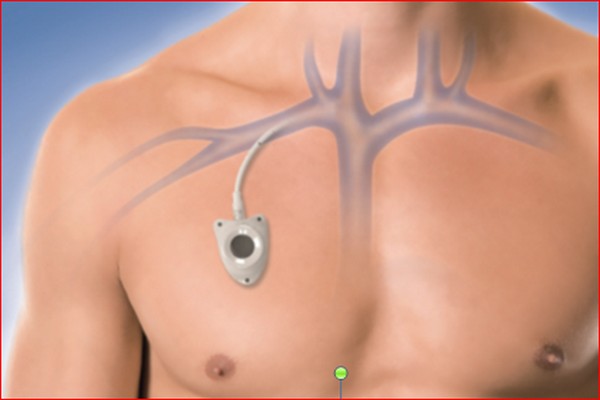Are you or a loved one facing long-term medical treatment? If so, you may have heard of a tiny device called a Portacath that can be your lifeline throughout the entire process. In this blog post, we will delve into the world of Portacaths and uncover how they work, their benefits and risks, as well as provide practical tips for caring for and living with one. Whether you’re new to the concept or seeking additional information, this guide is here to demystify the Portacath and help you navigate your medical journey with confidence. So let’s dive in!
How Does a Portacath Work?
The functioning of a Portacath is truly fascinating! This tiny device serves as a lifeline for individuals undergoing long-term medical treatments, such as chemotherapy or regular blood transfusions. But how does it actually work?
Let’s dive into the mechanics. A Portacath is a small implantable device that consists of two main components: the catheter and the port. The catheter is a thin tube made from biocompatible materials, which is inserted into a large vein in your chest or arm. The other end of the catheter connects to the port, which sits just below your skin.
This ingenious design allows healthcare professionals to easily access your bloodstream without having to search for veins each time you need treatment. They can simply insert a needle through your skin and into the port, providing direct access to deliver medications or draw blood samples.
But what about safety? Well, rest assured that Portacaths are designed with patient comfort and well-being in mind. The materials used are highly compatible with body tissues, reducing the risk of infection or rejection.
Moreover, these devices are so discreet that they can be hidden under clothing – nobody would even know you have one unless you choose to share it! Plus, since there’s no external tubing like with traditional IV lines, activities like showering become much easier without any restrictions!
In terms of maintenance, caring for your Portacath involves keeping the area clean and dry while ensuring regular flushing of saline solution through it when not in use. Your healthcare team will guide you on best practices specific to your situation.
Types of Portacaths
When it comes to choosing the right portacath for your long-term medical treatment, there are a few different options available. The type of portacath that is most suitable for you will depend on various factors such as your specific medical needs and personal preferences.
1. Single-lumen Portacath: This type of portacath has one tube that connects to a single chamber in the body, allowing for the administration of medications or fluids. It is commonly used for patients who require intermittent or short-term treatment.
2. Double-lumen Portacath: As the name suggests, this portacath has two separate tubes that connect to two chambers in the body. This design allows for simultaneous infusion and withdrawal of fluids or medications, making it ideal for patients who need frequent blood sampling or multiple treatments at once.
3. Subcutaneous Implantable Port: Unlike traditional portacaths which are placed directly into a major vein, subcutaneous implantable ports are inserted just below the skin surface and accessed using a special needle. They offer convenience and comfort to patients who prefer not having an external catheter visible.
Remember, when considering which type of portacath is best suited for you, consult with your healthcare provider who will guide you based on your individual needs and circumstances.
Benefits and Risks of Using a Portacath
When it comes to long-term medical treatment, the portacath has proven to be a game-changer for many patients. Let’s take a closer look at some of the benefits and risks associated with using this lifeline.
One of the greatest advantages of having a portacath is easy access for medical professionals. Unlike traditional IV lines that need to be inserted repeatedly, a portacath provides a permanent access point just beneath the skin. This means fewer needle sticks and less discomfort during treatment.
Another benefit is improved quality of life. With a portacath, patients can receive their treatments in various settings – whether it’s at home or in an outpatient clinic. This flexibility allows individuals to maintain their daily routines and reduces the need for frequent hospital visits.
In terms of risks, there is always a potential for infection when any foreign object penetrates the body. However, proper care and maintenance can greatly minimize this risk. Regular cleaning and monitoring by healthcare providers are crucial to ensure optimal functioning.
Another concern is blood clotting around the catheter tip, which could lead to complications such as blockage or difficulty infusing medications. To mitigate this risk, anticoagulant medications may be prescribed alongside regular flushing of the port.
While every medical procedure carries some degree of risk, it’s important to weigh these against the potential benefits that come with using a portacath. Consultation with your healthcare provider will help determine if this option is suitable for you based on your specific needs and condition.
Preparing for a Portacath Placement
When it comes to preparing for a portacath placement, there are a few important steps you need to take. First and foremost, it’s crucial to have open communication with your healthcare team. They will guide you through the process and answer any questions or concerns you may have.
Before the procedure, your doctor will likely ask about your medical history and perform some tests to ensure that you are in good health. It’s important to disclose any medications or allergies you may have during this time.
In some cases, fasting may be required prior to the placement of the portacath. Your doctor will give you specific instructions on when and how long to fast before the procedure.
On the day of the placement, make sure to wear comfortable clothing that allows easy access to your upper chest area. It’s also essential not to wear any jewelry or accessories that could interfere with the procedure.
It can be helpful mentally and emotionally to talk with others who have undergone a similar experience. Support groups or online forums can provide valuable insights into what to expect during and after portacath placement.
Remember, every individual’s experience is unique, so it’s vital always consult with your healthcare provider for personalized guidance on how best prepare for your portacath placement.
Caring for Your Portacath
Taking proper care of your portacath is essential to ensure its longevity and functionality. Here are some tips and tricks to help you maintain your portacath:
1. Keep the area clean: It’s important to keep the insertion site clean and dry at all times. Gently wash the area with mild soap and water, avoiding any harsh chemicals or scrubbing motions.
2. Be mindful of clothing choices: Opt for loose-fitting clothes that won’t rub against or irritate your portacath site. Avoid wearing tight belts, straps, or jewelry that could put pressure on the area.
3. Protect it during physical activities: If you engage in sports or exercise, consider using a padded cover or wrap around your portacath to protect it from potential impacts.
4. Follow proper flushing procedures: Regularly flush your portacath as per your healthcare provider’s instructions to prevent blood clot formation and maintain patency. Use sterile saline solution or heparin flushes as recommended.
5. Monitor for signs of infection: Watch out for redness, swelling, pain, warmth, or drainage at the insertion site – these could be signs of an infection. Contact your healthcare provider immediately if you notice any such symptoms.
Remember that caring for your portacath is a crucial part of ensuring successful long-term medical treatment! By following these simple tips and tricks, you can minimize complications and maximize the benefits provided by this lifeline device.
Living with a Portacath
Having a portacath can be life-changing for individuals requiring long-term medical treatment. It not only facilitates the administration of medication but also enables patients to lead more comfortable lives. But what is it really like to live with a portacath? Let’s hear from those who have firsthand experience.
For many, having a portacath means fewer needle sticks and less discomfort during treatments. Instead of enduring multiple IV insertions, they simply connect their medications or fluids directly into the port using a special needle. This convenience allows them to focus on other aspects of their daily lives without constantly worrying about finding veins or experiencing pain.
Another aspect that people appreciate is the discreet nature of this device. The port is usually placed beneath the skin in the chest area, making it easily concealable under clothing. This gives patients a sense of normalcy and helps them maintain their privacy while receiving treatment.
One common sentiment among those living with a portacath is gratitude for improved quality of life. Many express relief at being able to continue working or engaging in activities they enjoy without interruption due to frequent hospital visits for treatments.
However, some challenges exist as well. There may be occasional discomfort or soreness around the site where the catheter enters the body, especially after physical exertion or certain movements. Additionally, there might be some initial anxiety about handling and caring for the device properly, but healthcare professionals provide thorough instructions and support throughout this process.
Conclusion
The portacath is a vital medical device that provides a lifeline for individuals requiring long-term medical treatment. Its ability to deliver medications and draw blood without the need for constant needle sticks makes it a game-changer in healthcare.
Understanding how a portacath works, the different types available, and weighing the benefits against potential risks is essential for patients and caregivers alike. Proper preparation before placement and diligent care afterward can help ensure its longevity and effectiveness.







